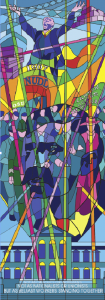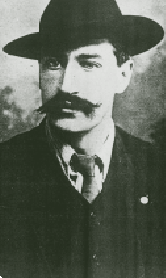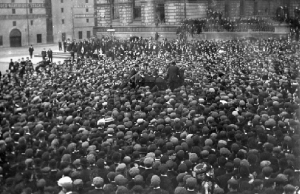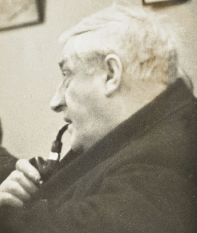Big Jim Larkin: Hero and Wrecker
Published in 18th-19th Century Social Perspectives, 1913, 20th Century Social Perspectives, 20th-century / Contemporary History, Features, Issue 4 (July-August 2013), Volume 21
The years from 1907 to 1913 would be Jim Larkin’s greatest, as represented in this 2007 stained glass window in Belfast City Hall by John McLaughlin to commemorate the centenary of the 1907 dockers’ strike. (Belfast City Council)
ITGWU founded
The ITGWU marked the birth of the modern Irish labour movement. Less than 10% of Irish workers were unionised at this time, and most of these were in British-based unions. In Dublin especially, many activists felt neglected by British labour and argued for an Irish-based movement. As an NUDL official, Jim had said that labour should be ‘international’. Once he launched the ITGWU, nationalism was water to the mill and Jim’s own sentimental Irishness came to the fore. He identified the union strongly with the Irish-Ireland movement, and it was he, rather than James Connolly, who made republicanism a force in the labour movement. The other big idea associated with the ITGWU was industrial unionism and the ambition to build ‘One Big Union’ for all workers, which Jim developed from his growing interest in syndicalism.
Up to mid-1911 Jim’s leadership of the ITGWU was an anti-climax. Now that he was his own boss, he began to be plagued by insecurity. Empathic and modest in dealing with union members, he could be petty and jealous if he scented a rival. Connolly especially felt ill treated by him, though their political ideas were remarkably in tune. In particular, Jim worried about money. While he lived frugally, he needed money constantly for his various schemes and dreams. Rather than expensive strikes, he hoped to prosecute the cause through making the ITGWU headquarters, Liberty Hall, a social centre and cultural powerhouse, and through a crusading paper, the Irish Worker, which he launched in May 1911. The Worker was a phenomenal success and showed Jim to be an editor of real ability. Weeks later came the sudden outbreak of ‘the Great Labour Unrest’, as it came to be called, in Britain, and its extension to Ireland drew the ITGWU into the forefront of conflict. Jim responded to the challenge, and the union grew from 5,000 to about 15,000 members, making it the major player in the Irish Trades Union Congress. Thanks largely to the ITGWU, Congress agreed in 1912 to establish the Labour Party. Jim was now at the zenith of his popularity and power and had no qualms about nurturing a personality cult. Paradoxically, success exacerbated his insecurity, and he threatened his health with a punishing work schedule.

Jim Larkin—like many socialists of the fin de siècle he was essentially a moralist who believed in setting a good example..
The glory years came to a shuddering halt with the 1913 Lockout. Jim was keen to reduce the ITGWU’s dependency on casual workers and push into steady employment sectors like the Dublin trams. But the tramways’ boss, William Martin Murphy, was disgusted at his colleagues’ gradual acceptance of Larkinism, and determined to extirpate any form of trade unionism that included sympathetic action. The extraordinary war, of 404 employers against over 20,000 workers, revealed how popular Larkinism was in Dublin and brought Jim international renown as a labour champion. It also nearly broke his health, and he was never the same again.
Freelance, globe-trotting public speaker in the US
After labour’s defeat in the Lockout, he became ever more difficult to work with. Privately, he wanted to move on from the wreckage, and in October 1914 he departed for the United States. He remained titular general secretary of the ITGWU. Most thought that he was leaving for a short recuperation. In reality, he was intent on a new career as a freelance, globe-trotting public speaker.
Never one for strategic planning, Jim mismanaged his American sojourn. In 1923 he would protest that he had gone to the US to liaise with Clan na Gael in plans for the Easter Rising. Certainly, he worked first with Clan na Gael and collaborated with German agents. While the American left opposed the war in Europe, it was alienated by his pro-German stance. Jim found it hard to earn a living as a socialist speaker, and from 1915 to 1917 he was bankrolled by the Germans in return for disrupting the pro-Allied US munitions industry. News of the Easter Rising had a depressing effect on him. He felt upstaged by Connolly and resented Connolly’s status as labour’s national martyr. After the Germans broke with him—for refusing to undertake sabotage operations, according to himself—he joined the Socialist Party in New York. Inspired by John Reed’s eyewitness reports of the Bolshevik revolution, he threw his energies into turning the Socialist Party into a communist party, making his flat in Greenwich Village the hub of the project. Arrested during the red scare of 1919, he was convicted of ‘criminal anarchy’ and imprisoned in Sing Sing.

Mass meeting in Belfast’s Queen’s Square in the summer of 1907, addressed by Joe Devlin MP, Jim Larkin, Lindsay Crawford, Alex Boyd and W.J. Murray. The Belfast dock strike made Larkin a household name. (Alex R. Hogg)
Jim was evidently tired of America by 1918 and tried repeatedly to get a passport for Ireland. Curiously, he never used his waterfront contacts to stow away aboard a ship, possibly because he preferred to travel in comfort in later life. Irish labour still believed in him, but the ITGWU was recovering rapidly from 1917 under the management of William O’Brien, who had grown to regard Jim as a dangerous loose cannon. Elizabeth too was slipping away from him. It had always been a marriage of ‘chalk and cheese’, and she yearned for a quieter life. She and the two youngest boys had joined him in Chicago in December 1915, before returning to Dublin in August 1916. In 1922 she refused to support a campaign to get him out of jail.
Deported to England
A relaxation of the red scare saw convict no. 50945 pardoned in January 1923. In April he was deported to England, mainly at the instigation of J. Edgar Hoover. The next ten years would be hell, as Jim vented his frustrations in outrageous behaviour that lost him allies on all sides. The Lockout had turned his egotism to egomania, and he had lived self-indulgently in the US, doing what he wanted, when he wanted, how he wanted. Back in Dublin, he surrounded himself with a dwindling band of admirers and brooked no criticism. At times he seemed oblivious to reality. He and Elizabeth separated, and the rift was made all the more painful by rumours that ITGWU president Tom Foran had come between them. Jim lived with his sister Delia and her husband. That too was painful, as for some years Jim and Delia were not on speaking terms. Jim also lost the union. The ITGWU would have welcomed him back in a more defined role. And the tragic irony was that, since the lockout, Jim didn’t want the drudgery of union work. But the sight of others running ‘his’ union provoked him into demanding the removal of rivals, notably O’Brien, and the restoration of his absolute command. A slanderous and self-centred assault on the union leadership led to his expulsion from the ITGWU in March 1924. In June, as he was en route to Moscow, his brother Peter and his favourite son, Young Jim, launched the Workers’ Union of Ireland (WUI) as a communist alternative to the ITGWU. Disillusioned by labour’s failure to resist the big attack on wages between 1921 and 1923, two thirds of the Dublin ITGWU went over to the WUI. The civil war in Dublin trade unionism would persist up to the 1960s.
Mellowed in old age

Larkin didn’t gamble, drink or smoke—though he would later take a cigar or a pipe. (National Museum of Ireland)
During the 1930s, when the Catholic Church mobilised against communism, he moved further to the centre. If the 1920s were hell, the 1930s were a purgatory in which he retreated from the limelight to concentrate on the ailing WUI and on building a support base for a seat on Dublin Corporation. By the 1940s he had mellowed. With his great ambitions behind him, and, by all accounts, a kinder, gentler manner, he enjoyed a partial rehabilitation in the labour movement. It was as much as he wanted. His activism on the Dublin trades council and on Dublin Corporation, where he prioritised the housing problem, and his role in opposing the Trade Union Act (1941) helped to restore his standing. In 1943 he was elected Labour TD for North East Dublin. O’Brien, however, had not forgiven or forgotten, and had ITGWU deputies split the Labour Party rather than accept Jim back into the fold.
Jim remained active to the last. In late 1946 he fell through a floor while supervising repairs to the WUI’s Thomas Ashe Hall. He died in the Meath Hospital on 30 January 1947. Archbishop John Charles McQuaid, with whom he was friendly, had hastened to the deathbed of his ‘most treasured conversion’, and said the requiem Mass. Jim had sensed that the end was near since Elizabeth’s death in 1945 and had been ambiguous about a final reconciliation with the Church. Some old Larkinites resented what they regarded as undue pressure from McQuaid.
The 50th anniversary of the Lockout marked the revival of the Larkin legend. To minimise controversy, it was for decades focused narrowly on 1913 and projected Jim sentimentally as the personification of solidarity. Conveniently, this also elided his communism, republicanism and opposition to British-based unions. Not for nothing has he been celebrated more in literature and art than in historiography. A black and white character, in his darkest years he dealt cruel blows to labour. Between 1907 and 1913 he was a magnificent leader and a visionary agitator. He can justly be remembered as the man who revolutionised trade unionism by breaking with the crippling policy of dependency on British labour, by introducing methods of struggle which made possible the unionisation of unskilled workers, and by ennobling those methods into a morality of struggle. HI
Emmet O’Connor lectures in history at the University of Ulster, Magee College.
Read More : Big Jim Larking Background
Read More : Relations with the USSR
Further reading
E. Larkin, James Larkin, 1876–1947: Irish labour leader (London, 1965).
D. Nevin (ed.), James Larkin: lion of the fold (Dublin, 1998).
E. O’Connor, James Larkin (Cork, 2002).
















